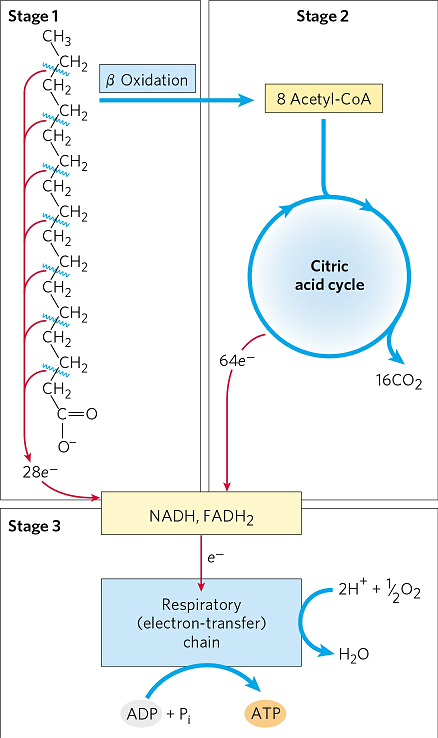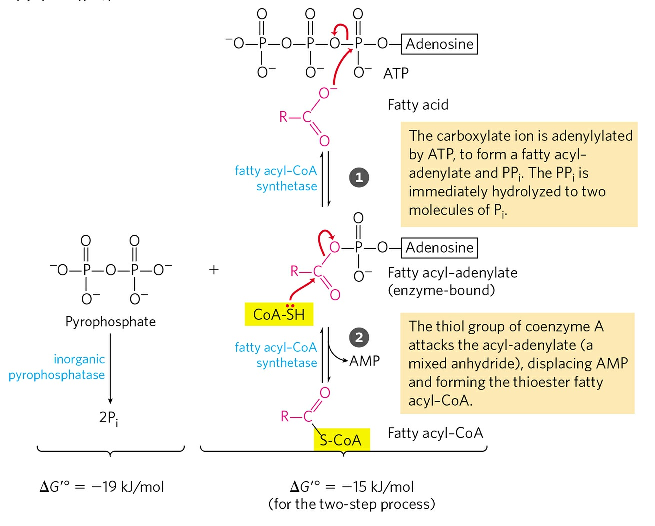
- Digestion of dietary lipids releases two important primary end products namely; fatty acids and glycerol.
- Fatty acids thus formed release a large amount of energy on oxidation, which involves three major steps.
- In the first stage called β oxidation, fatty acids undergo oxidative removal of successive two-carbon units in the form of acetyl-CoA, starting from the carboxyl end of the fatty acyl chain.
- In the second stage of fatty acid oxidation, the acetyl groups of acetyl CoA are oxidized to CO2 in the citric acid cycle, which also takes place in the mitochondrial matrix. Acetyl CoA derived from fatty acids thus enters a final common pathway of oxidation with the acetyl CoA derived from glucose via glycolysis and pyruvate oxidation.
- The first two stages of fatty acid oxidation produce the reduced electron carriers NADH and FADH2.
- In the third stage, NADH and FADH2 donate electrons to the mitochondrial respiratory chain, through which the electrons pass to oxygen with the concomitant phosphorylation of ADP to ATP. The energy released by fatty acid oxidation is thus conserved as ATP.
Steps in beta-oxidation of fatty acids:
1. Step I: Activation of a fatty acid by conversion to a fatty acyl CoA
-
- After fatty acid enters into the cell, it is converted into fatty acyl CoA.
- The conversion is catalyzed by fatty acyl-CoA synthetase or thiokinase and inorganic pyrophosphatase. Formation of the fatty acyl CoA derivative occurs in two steps.
2. Step II: Transport of fatty acid from cytosol into mitochondria via the acyl carnitine/carnitine transporter
-
- Fatty acyl CoA must enter into mitochondrial matrix where β-oxidation occurs.
- Shorter chain fatty acids (less than 12 Carbon atoms) cross mitochondrial membranes by themselves and enter into the matrix.
- Longer chain fatty acids however, need carnitine shuttle to cross the mitochondrial membranes.
- First, acyl group of fatty acyl CoA is transported to carnitine to form fatty acyl carnitine and free CoA. This reaction is catalyzed by carnitine acyl transferase I (CPT-I) present on the outer membrane of mitochondria.
- Fatty acyl carnitine then enters into mitochondrial matrix with the help of carnitine-acyl-carnitine transporter protein (carnitine shuttle).
- Finally, carnitine acyl transferase II (CAT-II) transfers acyl group from fatty acyl carnitine to mitochondrial coenzyme A, freeing carnitine to return to the inter-membrane space through the same transporter protein. The carnitine is released and return to cytosol for reuse.
3. Step III: Beta oxidation
a. β-oxidation of saturated fatty acids (E.g. Palmitic acid)
- The first cycle of beta oxidation of saturated fatty acids consists of a sequence of four enzyme-catalyzed reactions that result in the shortening of fatty acid chain by two-carbon atoms.
i. First Oxidation step: In the first step, dehydrogenation of fatty acyl CoA produces a double bond between α and β carbon atoms (C-2 and C-3), yielding an enoyl CoA and FADH2 in the presence of an enzyme fatty acyl CoA dehydrogenase.
ii. Hydration step: In the second step, water is added to the double bond of enoyl CoA to form β-hydroxyacyl CoA (3-hydroxyacyl-CoA). This reaction is catalyzed by enoyl CoA hydratase.
iii. Second oxidation step: In the third step, β-hydroxyacyl CoA is dehydrogenated to form β-ketoacyl CoA (3-ketoacyl CoA), by the action of β-hydroxyacyl CoA dehydrogenase. NADH is produced in this step.
iv. Thiolysis or Thiolytic cleavage step: The fourth and last step of the β-oxidation cycle is catalyzed by acyl CoA acetyl transferase, more commonly called thiolase, which promotes reaction of β-ketoacyl CoA with a molecule of free coA to split off the carboxyl terminal (two-carbon fragment) of the original fatty acid as acetyl CoA. The other product is fatty acyl CoA, now shortened by two carbon atoms. This reaction is called thiolysis.
- These four steps make one complete cycle of beta oxidation. In each cycle, one acetyl CoA, one FADH2 and one NADH are produced.
Energy yield from β-oxidation of Palmitic acid:
-
- Palmitic acid yields 7 NADH + 7 FADH2 + 8 acetyl CoA in 7 cycles of mitochondrial beta oxidation.
- Every acetyl CoA yields 3 NADH + 1 FADH2 + 1 GTP (=ATP) during Krebs cycle. Considering an average production of 3 ATP per NADH and 2 ATP per FADH2 using the respiratory chain, we have 131 ATP molecules.
- However, 2 ATP molecules are used for the initial activation of every fatty acid that is going to be oxidized in the mitochondria. Hence, net 129 ATP molecules are produced.
b. β-oxidation of unsaturated fatty acids:
i. β-oxidation of mono-unsaturated fatty acids (E.g. Oleic acid):
-
- Most of the fatty acids in triacylglycerols and phospholipids of animals and plants are unsaturated, i.e. having one or more double bonds.
- Two auxiliary enzymes, an isomerase and a reductase are needed for the β oxidation of common unsaturated fatty acids.
- Oleate (Oleic acid) is an abundant 18-carbon mono-unsaturated fatty acid with a cis double bond between C-9 and C-10 (denoted Δ9).
- In the first step of oxidation, oleate is converted to oleoyl CoA and, like the saturated fatty acids, enters the mitochondrial matrix via the carnitine shuttle.
- Oleoyl-CoA then undergoes three β-oxidation cycles to yield three molecules of acetyl-CoA, 3 NADH and 3 FADH2 and the coenzyme A ester of a Δ3, 12-carbon unsaturated fatty acid, cis-Δ3-dodecenoyl-CoA. This product cannot serve as a substrate for enoyl-CoA hydratase, which acts only on trans double bonds.
- The auxiliary enzyme, Δ3, Δ2-enoyl-CoA isomerase isomerizes the cis-Δ3-enoyl-CoA to the trans-Δ2-enoyl-CoA, which is converted by enoyl CoA hydratase into the corresponding β-hydroxyacyl CoA (trans-Δ2-dodecenoyl CoA).
- This intermediate is now acted upon by the remaining enzymes of β oxidation to yield acetyl CoA and the coenzyme A ester of a 10-carbon saturated fatty acid, decanoyl CoA.
- The latter undergoes four more passes through the β-oxidation pathway to yield five more molecules of acetyl CoA. Altogether, nine molecules of acetyl CoA are produced from one molecule of 18-carbon oleate.
ii. β-oxidation of poly-unsaturated fatty acids (E.g. Linoleic acid):
-
- 18-carbon Linoleate (Linoleic acid), has a cis-Δ9, cis-Δ12 configuration and enters the β-oxidation cycle as linoleoyl CoA (Δ 9,12).
- Linoleoyl CoA undergoes three β-oxidation cycles to yield three molecules of acetyl CoA and the coenzyme A ester of a 12-carbon unsaturated fatty acid with a cis-Δ3,cis-Δ6
- This intermediate cannot be used by the enzyme of the ß-oxidation pathway because its double bonds are in the wrong position and have the wrong configuration (cis, not trans).
- Hence, oxidation requires a second auxiliary enzyme, NADPH dependent 2,4-dienoyl-CoA reductase, in addition to enoyl CoA isomerase.
- The combined action of these two enzymes converts a trans-Δ2, cis-Δ4-dienoyl CoA intermediate to the trans-Δ2-enoyl-CoA substrate that can enter the β-oxidation pathway and be degraded to six molecules of acetyl CoA. The overall result is conversion of linoleate to nine molecules of acetyl CoA.
c. β-oxidation of fatty acids with odd number of Carbon atoms:
- Long-chain odd-number fatty acids are oxidized in the same pathway as the even-number acids, beginning at the carboxyl end of the chain.
- However, the substrate for the last cycle through the β-oxidation sequence is a fatty acyl CoA with a five-carbon fatty acid. When this is oxidized and cleaved, the products are acetyl-CoA and propionyl CoA.
- Complete oxidation of this Propionyl CoA requires three extra reactions.
- Propionyl CoA is first carboxylated to form the D-methyl malonyl CoA by propionyl CoA carboxylase.
- The D-methyl malonyl CoA thus formed is enzymatically epimerized to L-methyl malonyl CoA by methylmalonyl CoA epimerase.
- The L-methylmalonyl-CoA then undergoes an intra-molecular rearrangement to form succinyl-CoA, which can enter the citric acid cycle.
- This rearrangement is catalyzed by methyl malonyl CoA mutase, which requires as its coenzyme 5′-deoxyadenosylcobalamin, or coenzyme B12, which is derived from vitamin B (cobalamin).






